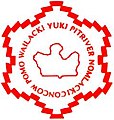Fitxer:Round Valley Seal.jpg
Round_Valley_Seal.jpg (239 × 252 píxels, mida del fitxer: 14 Ko, tipus MIME: image/jpeg)
| Aquest fitxer i la informació mostrada a continuació provenen del dipòsit multimèdia lliure Wikimedia Commons. |
Resum
| DescripcióRound Valley Seal.jpg |
LOCATION AND LAND STATUS: The Round Valley Reservation, which is actually in a geographically round valley, is located in the northeastern part of Mendocino County. It is the second largest reservation in California. The isolated valley is situated within the second coastal mountain range and is approximately 60 miles inland from the Pacific Ocean. The reservation was originally established by Executive Order of November 18, 1858. A second Executive Order of March 30, 1870, enlarged the reservation, and the borders were further defined by a third Executive Order of May 18, 1875. The Camp Wright Military Reserve was added to the reservation in 1876. Originally, the reservation covered over 102,000 acres. Today ownership of the 30,537.51 acres is a mosaic divided between tribal lands under individual Indian family ownership and trust lands. CLIMATE: Round Valley Reservation is located in the transition zone between coastal and interior climates. Rainfall measures about 35 inches per year, and temperatures range from 102 degrees to a low of 29 degrees. CULTURE AND HISTORY: Historically, the Round Valley Reservation was the "depository" for tribes which were rounded up by the U.S. Army during the decade between 1855-65. Members of the Nomlaki, Yuki, Wailaki, Konkow, Pit River, Achumawi, Pomo, and Wintun tribes currently are members of the Covelo Indian Community. With this convergence of various peoples, several cultures have disappeared or become totally merged with others. The Yuki people have lived in Round Valley for thousands of years. The reservation itself, established in 1856 as the Nome Cult Indian Farm, represents one of the oldest reservations in California. In 1854, on the eastern foothills of the Coast Range, the large Nome Lackee Reservation had been established, and the vestiges of many cultural groups living around Central Valley were removed to it. When Euro-American settlers claimed this land in 1863, these people were herded over the mountains to Round Valley, with considerable loss of life, during a two-week "trail of tears." Old Fort Wright, which was added to the reservation, was abandoned in 1876 and converted into an Indian boarding school in 1883. Nothing remains of either, except a former officer?s home. POMO - The Pomo people, traditionally speaking seven related but mutually unintelligible languages, still live in their ancestral lands in northwestern California. Their languages belong to the Hokan family, related to the languages of people from the northernmost part of the state southward into Mexico and eastward into the Great Basin and the Southwest. Along the coast they made their living by gathering shellfish and fishing, relying secondarily on acorns and game; along major rivers they were able to depend on king salmon and to some extent on acorns and game. Today approximately 5,000 Pomo people live on or near the Big Valley, Cloverdale, Dry Creek, Grindstone, Guidiville, Hopland, Lytton, Manchester/Point Arena, Middletown, Pinoleville, Potter Valley, Redwood Valley, Robinson, Scotts Valley, Sherwood Valley, Stewarts Point, and Upper Lake rancherias, the Coyote Valley and Round Valley reservations, and the Elem Indian Colony. YUKI - The ancestral lands of the Yuki people are located in northwestern California, just south of the area historically occupied by Athabascan speakers. Their language, together with Wappo, forms one branch of the Penutian family, which includes a large group of central and northern California languages, in addition to languages spoken all the way from coastal Canada to the Gulf of Mexico, and south to the Yucatan Peninsula of Mexico. There are, however, no speakers of Yuki today. Along the coast, people traditionally depended on fish and shellfish, with land resources of secondary importance; along the major rivers, king salmon formed the main staple food resource, with acorns and game of lesser prominence; and in the foothills of the Coast Range, acorns formed the most important staple, followed by other vegetable foods and game. Today there are about 85 Yuki people, approximately 50 of whom live on the Round Valley Reservation, in addition to descendants of more mixed heritage. PIT RIVER (ACHUMAWI, AJUMAWI, ATSUGEWI, APORIGE, ASTARIWI, ATWAMSINI, HAMMAWI, HEWISEDAWI, ILMAWI, ITSATAWI, KOSEALEKTE, MADESI) - The eleven bands of the Pit River Tribe have traditionally occupied lands along the Pit River and its tributaries, in the far northeastern part of the state. Their languages, Achumawi and Atsugewi, are closely related Hokan languages, belonging to a family of languages spoken by people from northern California south into Mexico and east across the Great Basin into the Southwest. Traditionally their way of life depended on fish and other river resources, as well as on acorns and other vegetable foods growing in the river valleys. Today the 1,350 or so tribal members live on the Alturas, Big Bend, Likely, Lookout, Montgomery Creek, Redding, Roaring Creek, and Susanville rancherias, as well as on the Pit River and Round Valley reservations. WAILAKI - The traditional lands of the Wailaki people are located in the northwestern corner of the state, 50 miles or so inland from the Pacific Coast, mainly in the foothills of the Coast Range. Their language belongs to the Athabascan language family, related not only to other languages in northwestern California, but also to the languages of the interior of Alaska and Canada and to Navajo and Apache in the Southwest. Their traditional way of life combined the use of acorns as the principal staple with other vegetable foods and game and, along the main rivers, with salmon. At the present time, many of the approximately 1,000 Wailaki people live on the Round Valley Reservation; in 1991 a group was formed to seek separate federal recognition of the tribe, apart from the Round Valley organization. WINTUN (WINTU, NOMLAKI, NOMELAKI, PATWIN) - There are three divisions of the Wintun people: the Wintu, Nomlaki, and Patwin. Their traditional lands are located in the greater Sacramento Valley, with the Sacramento River a major feature of all the regions, from the Wintu mountain rivers in the north, through the Nomlaki plains, to the marshes, valleys, and hills of the Patwin. Their languages are of the Penutian family, which includes a large group of central and northern California languages, in addition to languages spoken all the way from coastal Canada to New Mexico, the Gulf of Mexico, and on to the Yucatan Peninsula. In some areas, they were able to depend on the semiannual runs of king salmon up major rivers; in some the resources were more mixed, with both fish and land resources being of about equal weight; and in others, the pattern of dependence on acorns with secondary use of other vegetable foods and game prevailed. Today there are approximately 2,500 people of Wintun descent; many live on the Colusa, Cortina, Grindstone Creek, Redding, and Rumsey rancherias, as well as the Round Valley Reservation. MAIDU (MECHOOPDA, TYME, CONCOW, ESTOM YUMEKA) - The traditional lands of the Maiduan peoples were in the north-central part of the state. The three closely related peoples usually called Maidu were the Maidu of Plumas and Lassen counties, the Concow of Butte and Yuba counties, and the Nisenan of Yuba, Nevada, Placer, Sacramento, and El Dorado counties. Their languages are of the Penutian family, which includes a large group of central and northern California languages, in addition to languages spoken all the way from coastal Canada to New Mexico, the Gulf of Mexico, and on to the Yucatan Peninsula. Their traditional way of life ranged from the valley ecological type, dependent on mixed resources of fish and vegetables (mainly tule and acorns), to the foothills ecological type, the classic California way of life dependent mainly on acorns and some small game. Today approximately 2,500 Maiduan people live on the Auburn, Berry Creek, Chico, Enterprise, Greenville, Mooretown, and Susanville rancherias, as well as the Round Valley Reservation. GOVERNMENT: The tribe's constitution and bylaws, prepared according to the Indian Reorganization Act of 1934, were approved on December 16, 1936. The Tribal Charter was ratified the following year. The reservation is governed by the seven-member elected Covelo Indian Community Council, which includes a chairperson, vice-chairperson, secretary, treasurer, and sergeant-at-arms. |
| Data | |
| Font |
|
| Autor | Nathan Soliz from Redding, United States |
Llicència
- Sou lliure de:
- compartir – copiar, distribuir i comunicar públicament l'obra
- adaptar – fer-ne obres derivades
- Amb les condicions següents:
- reconeixement – Heu de donar la informació adequada sobre l'autor, proporcionar un enllaç a la llicència i indicar si s'han realitzat canvis. Podeu fer-ho amb qualsevol mitjà raonable, però de cap manera no suggereixi que l'autor us dóna suport o aprova l'ús que en feu.
- compartir igual – Si modifiqueu, transformeu, o generareu amb el material, haureu de distribuir les vostres contribucions sota una llicència similar o una de compatible com l'original
| Aquesta imatge, originalment publicada a Flickr, ha estat verificada el May 22, 2010 per l'administrador o usuari acreditat File Upload Bot (Magnus Manske), i ha confirmat que en aquella data estava disponible a Flickr sota la llicència indicada. |
Llegendes
Elements representats en aquest fitxer
representa l'entitat
5 feb 2008
Historial del fitxer
Cliqueu una data/hora per veure el fitxer tal com era aleshores.
| Data/hora | Miniatura | Dimensions | Usuari/a | Comentari | |
|---|---|---|---|---|---|
| actual | 20:53, 22 maig 2010 |  | 239 × 252 (14 Ko) | File Upload Bot (Magnus Manske) | {{Information |Description=LOCATION AND LAND STATUS: The Round Valley Reservation, which is actually in a geographically round valley, is located in the northeastern part of Mendocino County. It is the second largest reservation in California. The isolat |
Ús del fitxer
La pàgina següent utilitza aquest fitxer:
Ús global del fitxer
Utilització d'aquest fitxer en altres wikis:
- Utilització a en.wikipedia.org
- Utilització a fy.wikipedia.org
- Utilització a tr.wikipedia.org
- Utilització a www.wikidata.org
Metadades
Aquest fitxer conté informació addicional, probablement afegida per la càmera digital o l'escàner utilitzat per a crear-lo o digitalitzar-lo. Si s'ha modificat posteriorment, alguns detalls poden no reflectir les dades reals del fitxer modificat.
| _error | 0 |
|---|


